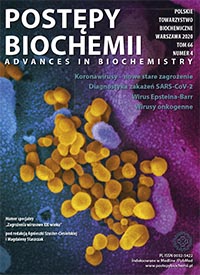Molecular diagnosis of COVID-19 â present experiences
DOI:
https://doi.org/10.18388/pb.2020_363Abstract
Severe acute respiratory syndrome Coronavirus-2 (SARS-CoV-2), a new highly emerging and pathogenic for human RNA virus, is responsible for the present COVID-19 pandemic. Molecular diagnostic methods, including real-time reverse transcription-PCR (RT-PCR) assay are the recommended methods for the identification and laboratory confirmation of COVID-19 cases. RT-PCR allows for detection the RNA of the virus in clinical specimens from patients suspected of COVID-19 with high specificity and sensitivity. Testing is still crucial for rapid detection of infected persons, implementation of appropriate measures to suppress further virus transmission and mitigate its impact. In response to demand of a molecular diagnostic test for SARS-CoV-2, within a first few months ongoing pandemic many commercial kits has become available on the market. However, these tests have varied in number and type of molecular targets, time of reaction as well as quality. In this study we compared different commercial tests for the detection of SARS-CoV-2 in clinical samples sending to Laboratory of Department of Virology, NIPH-NIH.
Downloads
Published
Issue
Section
License
Copyright (c) 2021 Advances in Biochemistry

This work is licensed under a Creative Commons Attribution 4.0 International License.
All journal contents are distributed under the Creative Commons Attribution-ShareAlike 4.0 International (CC BY-SA 4.0) license. Everybody may use the content following terms: Attribution — You must give appropriate credit, provide a link to the license, and indicate if changes were made, ShareAlike — If you remix, transform, or build upon the material, you must distribute your contributions under the same license as the original. There are no additional restrictions — You may not apply legal terms or technological measures that legally restrict others from doing anything the license permits.
Copyright for all published papers © stays with the authors.
Copyright for the journal: © Polish Biochemical Society.




